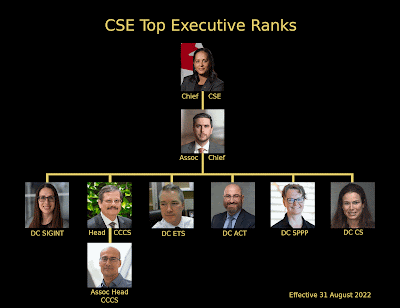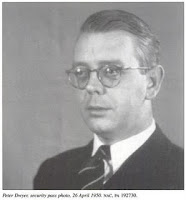Diversity in the top ranks of CSE
Improving diversity within CSE and other parts of the
intelligence community is an ongoing challenge, but with the appointment of the
first non-white Canadian to the position of Chief of CSE
(effective August 31st), I thought I'd take a look at how things are going at the
top level of the agency's hierarchy. As the chart below shows, that group is actually
pretty diverse.
CSE doesn't keep me updated on its executive appointments (or any other matter), so it's possible that some of the incumbents in these positions have changed, but this chart should be pretty close.
Of the nine officials shown in the chart, four are women, and five (three men and two women) are non-white. Some of the officials may also belong to other traditionally excluded or under-represented groups, such as 2SLGBTIQ+ persons, religious minorities, or persons with disabilities, but I have no information about that.
Dwyer straits
CSE wasn't always as diverse as this. There was a time, in fact, when the battle for diversity in the upper ranks of the agency meant a demand to hire more (white) Canadian men instead of so many (white) British men.As far as I can tell, CSE never had employment
policies as overtly racist as those at GCHQ, which systematically barred all "coloured"
people from employment at the agency until the 1980s,
or even those at NSA and its predecessors, where, for example, until 1956
almost all African American employees were concentrated in a low-paid,
segregated unit dubbed, inevitably, "the Plantation".
But of course a lack of evidence of egregious racism in no
way means that no racist or otherwise discriminatory practices existed at CSE. And
there is no reason to assume the agency has been any less discriminatory in its
practices than the overall public service, or indeed Canadian society in
general.
It wasn't until 1977 that CSE even established an advisory position on equal opportunities for women. Like today, about one-third of CSE's staff at that time were women, but they were "concentrated in lower level - lower paying jobs" such as clerical and secretarial work and were rarely promoted to upper management positions. As I noted here, the top echelons of the agency have come a long way in that respect since then.
Statistics on equity, diversity, and inclusion across the entire staff of CSE are hard to come by, but they have started to be reported in recent years. CSE's most recent annual report, for example, published these statistics on employment equity representation versus workforce availability (click image for larger version):
As these numbers show, CSE still has a long way left to go with respect to persons with disabilities and those described as "visible minorities". (The term "visible minorities," the report notes, "is considered outdated. We use it here in the context of the Employment Equity Act, which is currently under review.")
It's also worth recognizing that the "workforce availabilities" shown in CSE's chart relate to the specific occupational categories CSE seeks to fill and thus themselves reflect persisting societal and systemic barriers to inclusion. As target levels they are at best relative measures of progress.
This can be seen in the statistics pertaining to women, who are assessed as having a workforce availability of 35.4% for CSE even though they represent 50.4% of Canada's population and their availability for the public service as a whole is assessed to be 52.7%.
The same point could be made with respect to Indigenous people. While CSE seems to be doing reasonably well, with Indigenous people representing 1.93% of the agency's staff versus a workforce availability of 2.08%, the assessed availability of Indigenous people with respect to the public service as a whole is twice as high (4.0%), suggesting there is a lot of room for growth if obstacles to participation in occupations of interest to CSE were reduced.
NSICOP's study of diversity and inclusion in the Canadian security and intelligence community, published in 2020, provides a useful further discussion of these issues and some additional statistical information, notably representation at the executive level of Canadian S&I agencies in 2017-18. (I'm not sure where the cut-off for this category is in CSE, but it likely includes everyone from the Chief down to the Director-General and, I would guess, Director level.) Interestingly, CSE significantly under-performed in terms of visible minority representation within the executive category at that time.
As the NSICOP report and the CSE annual report both acknowledge, women, Indigenous people, persons with disabilities, and visible minorities are not the only groups relevant to questions of equity, diversity, and inclusion.
In May 2021, a senior official from CSE's SIGINT branch,
Artur Wilczynski, was appointed Assistant Deputy Minister, Senior Advisor for
People, Equity, Diversity and Inclusion as part of "a focused effort to
bolster a welcoming and inclusive community at CSE, to identify and break down
systemic barriers to full participation, and to help empower historically
discriminated against groups within the Public Service." Prior to his
retirement earlier this summer, Wilczynski oversaw the production of CSE's
first equity, diversity, and inclusion guide, which incorporates this broader
understanding of equity-deserving groups, including the 2SLGBTIQ+ community,
religious minorities, the neurodivergent, and others.
This episode of the Intrepid podcast, featuring Wilczynski and Nabih Eldebs (then the Director General of Policy, Disclosure and Review at CSE), is also a good source of information on the recent state of play at the agency.
Conclusion
Obviously, the presence of women and non-white people in key leadership positions at CSE does not mean that problems of systemic discrimination and under-representation no longer exist at the agency, or even necessarily that meaningful progress is being made. And it would certainly be a mistake to use year-to-year changes in appointments to upper executive positions as a measure of the agency's overall progress or lack thereof. But representation does matter. The agency seems to be making good-faith (if undoubtedly imperfect) efforts to improve its performance on these issues at all levels of the organization, and in that context the fact that the top levels of CSE are visibly diverse sends an important message of hope that all Canadians can find a home at the agency.




